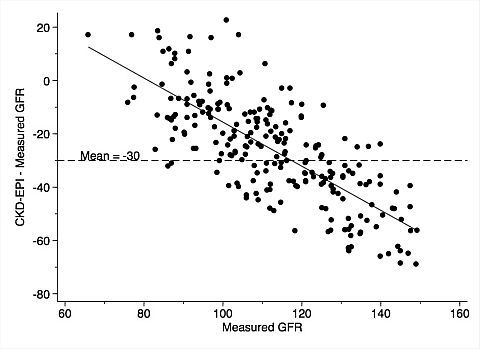Role of Estimated GFR CKD-EPI as Screening Tool for Donor Selection
Nephrology, Columbia University Medical Center, New York, NY
Surgical Transplant Nephrology, Columbia University Medical Center, New York, NY
Meeting: 2013 American Transplant Congress
Abstract number: B916
Purpose: Living donor selection usually includes a measured renal function rather than estimated GFR (eGFR) equations, such as CKD-EPI because of concerns of accuracy. However, at Columbia University Medical Center, we use an eGFR threshold of 100 ml/min as a screening tool to identify patients who need to have their measured renal function to avoid using potential donors with renal function of < 80 ml/min/1.73m2.
Methods: Retrospective cohort study of all potential living kidney donors with eGFR by CKD-EPI <100 ml/min/1.73m2 who underwent subsequent iothalamate plasma clearance (iGFR) to quantify renal function.
Results: Between 2008 to 2012, 441 live donors were evaluated, of which 253 (57%) required had an eGFR <100 ml/min. The mean CKD-EPI and iGFR were 86.8±13.4 and 116.8 ±25.6ml/min/1.73m2. The bias (eGFR-iGFR) and precision (SD of bias) were -30 and 26.4ml/min/1.73m2. The accuracy (10, 20% of values for the CKD-EPI within 10, 20% of the iGFR) were 14% and 39%, respectively. Among these potential donors an eGFR of ≥ 100 mL/min, only 2% were noted to have a mGFR < 80mL/min.

Conclusion: Our results suggest that the use of a high threshold of eGFR such as 100mL/min in the evaluation of donors decreases the need for measurement of renal function in all donors while at the same time limiting the risk of kidney donation from subjects with suboptimal renal function.
To cite this abstract in AMA style:
Fernandez S, Mohan S, Zaky Z, Crew J, Dube G, Wexler J, Carrol M, Ratner L, Cohen D, Tanriover B. Role of Estimated GFR CKD-EPI as Screening Tool for Donor Selection [abstract]. Am J Transplant. 2013; 13 (suppl 5). https://atcmeetingabstracts.com/abstract/role-of-estimated-gfr-ckd-epi-as-screening-tool-for-donor-selection/. Accessed December 12, 2025.« Back to 2013 American Transplant Congress
